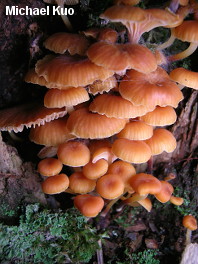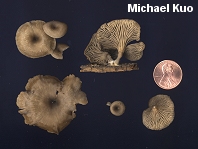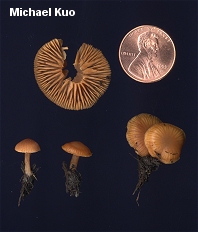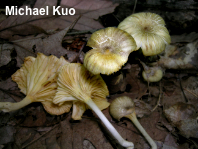| Major Groups > Gilled Mushrooms > Pale-Spored > Omphalinoid Mushrooms |

|
Omphalinoid Mushrooms [ Basidiomycota . . . ] by Michael Kuo "Omphalinoid" mushrooms form a fairly distinctive group among the gilled mushrooms; they are small species with true gills that run down the stem, thin stems, and caps that are funnel-shaped or depressed by maturity ( The genus names involved with omphalinoid mushrooms change every second Tuesday, give or take, but Omphalina was obviously once one of the forerunners. Other genera include Arrhenia, Gerronema, Lichenomphalia, Xeromphalina, Chrysomphalina, and Rickenella—and many species of clitocyboid mushrooms are omphalinoid (a fact you should avoid if you're paranoid). I would share with you the various features that separate these genera, but they are often obscure (for example, the "sarcodimitic tissues" of Gerronema) and, more importantly, likely to change before you read this, as DNA studies attempt to sort this mess out. So far these studies have only confused things further (and by "things" I mean "me") by throwing some of the waxy caps into the genetic mix, but we can always hope. Omphalinoid Mushroom Pages: Chrysomphalina chrysophylla |
© MushroomExpert.Com |
|
References Bigelow, H. E. (1970). Omphalina in North America. Mycologia 62: 1–32. Bigelow, H. E. (1982). North American species of Clitocybe. Part I. Germany: Cramer. 280 pp. Bigelow, H. E. (1985). North American species of Clitocybe. Part II. Germany: Cramer. 191 pp. Elborne, S. A. (2018). Lichenomphalia Redhead, Lutzoni, Moncalvo & Vilgalys. In Knudsen, H. & J. Vesterholt, eds. Funga Nordica: Agaricoid, boletoid, clavarioid, cyphelloid and gastroid genera. Copenhagen: Nordsvamp. 293–295. Geml, J., F. Jauff, C. Brochmann, F. Lutzoni, G. A. Laursen, S. A. Redhead & D. L. Taylor (2012). Frequent circumarctic and rare transequatorial dispersals in the lichenised agaric genus Lichenomphalia (Hygrophoraceae, Basidiomycota). Fungal Biology 116: 388–400. Lange, M. (1981). Typification and delimitation of Omphalina Quel. Nordic Journal of Botany 1: 691–696. Lutzoni, F. M. (1997). Phylogeny of lichen- and non-lichen-forming omphalinoid mushrooms and the utility of testing for combinability among multiple data sets. Systematic Botany 46: 373–406. Miller, O. K. Jr. (1968). A revision of the genus Xeromphalina. Mycologia 60: 156–188. Norvell, L. L. et al. (1994). Omphalina sensu lato in North America 1–2. 1: Omphalina wynniae and the genus Chrysomphalina. 2: Omphalina sensu Bigelow. Mycotaxon 50: 379–407. Redhead, S. A. & Weresub, L. K. (1978). On Omphalia and Omphalina. Mycologia 70: 556–568. Redhead, S. A. (1986). Mycological observations 15–16: On Omphalia and Pleurotus. Mycologia 78: 522–528. Redhead, S. A. et al. (1995). Omphalina sensu lato in North America 4: O. rosella. Mycologia 87: 880–885. Redhead, S. A., J.-M. Moncalvo, R. Vilgalys & F. Lutzoni (2002). Phylogeny of agarics: Partial systematics solutions for bryophilous omphalinoid agarics outside of the Agaricales (Euagarics). Mycotaxon 82: 151–168. Redhead, S. A. et al. (2002). Phylogeny of Agarics: Partial systematics solutions for core omphalinoid genera in the Agaricales (Euagarics). Mycotaxon 83: 19–57. Singer, R. (1964). Die gattung Gerronema. Nova Hedwigia 7: 53–92. Voitk, A., I. Saar, R. Lebeuf & P. Kennedy (2020). The Pseudoomphalina kalchbrenneri complex in North America. Botany 98: 91–101. This site contains no information about the edibility or toxicity of mushrooms. Cite this page as: Kuo, M. (2020, September). Omphalinoid mushrooms. Retrieved from the MushroomExpert.Com Web site: http://www.mushroomexpert.com/omphalinoid.html |



